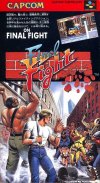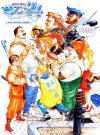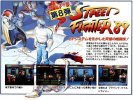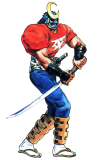DoABarrelRoll
Novice
How Final Fight was made
 youtu.be
View attachment 803
youtu.be
View attachment 803
The story behind the creation of "Final Fight" involved a team of developers who faced many obstacles and made creative decisions that shaped the iconic game it is known today. The narrative behind this process reveals the inspirations, influences and challenges the developers faced in creating one of the most remarkable games in the beat-'em-up genre.
After the release of "Forgotten Worlds" in 1988, Capcom began its search for the next project. It was in this context that the conception of a new side-scrolling action game began to materialize. The team wanted an immersive and exciting experience for players. In that sense, Yoshiki Okamoto, the director and mind behind "Final Fight", found inspiration in the emerging arcade scene.

The "beat-'em-up" genre was on the rise at the time, with titles such as "Double Dragon II: The Revenge" gaining prominence. Okamoto decided to create his own interpretation of this style of play. Drawing on many elements of double dragon such as setting, story and gameplay.
It is worth remembering that Capcom planned to release the sequel to its Fighting game Street Fighter, but due to the scarcity of rom chips in the world, it focused on creating Final Fight.
View attachment 805
In this context, the idea of "Final Fight" arose. The team conceived an action game packed with action and distinct elements. However, due to memory constraints, developers had to get creative in optimizing available resources. The conception of urban scenarios, inspired by works such as "Streets of Fire", directed by Walter Hill, began to take shape.
View attachment 806
The choice of Capcom's CPS-1 board represented a turning point. Equipped with a 10 MHz Motorola 68000 processor and the ability to display 4096 colors simultaneously, this card played a key role in the creation of "Final Fight".
The CPS-1 stood out not only for its power, but also for its modular approach that facilitated component replacement, optimizing costs and streamlining game development.

The Creative Process and Collaboration
The game's development team has worked tirelessly to create endearing characters and immersive environments. Okamoto and his team were very inspired by the movie "Streets of Fire", to mold characters like Cody Travers, in the creation of scenarios, names of enemies and etc . Creating these elements involved full collaboration between team members.
Initially, Ryu and Ken, from "Street Fighter", were considered as protagonists. However, player feedback and the quest for originality prompted a creative revamp. The "Big and Awesome" Approach
View attachment 808
The "Huge and Awesome" Approach
One of the central approaches in conceiving "Final Fight" was the notion of "huge and incredible". The team recognized that visually imposing characters were endearing to players. This led to the creation of characters larger than the standard for side-scrolling games at the time, allowing them to stand out on screen despite memory limitations.
The fictional city of Metro City was meticulously crafted, blending 1980s urban aesthetics with elements of the cyberpunk genre, resulting in an immersive environment that has captivated players around the world.
Metro City also served as the setting for the game "Captain Commando" in the future.
Mike Haggar, a former wrestler turned mayor, is galvanized into action when his daughter, Jessica, is kidnapped by the Mad Gear gang. Her courage propels him to rescue her and cleanse the city of corruption.
Cody Travers, Jessica's boyfriend, joins the mission to rescue Haggar, bringing his street-fighting techniques and knife skills.
Guy, a martial arts master and friend of Cody's, also joins the fight, adding a strategic dimension to the team.
Cinematic influences are noticeable, with characters inspired by figures such as Jean-Claude Van Damme. The soundtrack also pays homage to the band Guns N' Roses.
The game not only attracted attention for its continue screen, but also contained curious references. The antagonist gang, Mad Gear Gang, originated from Capcom's racing game "Led Storm", released in 1987.
Members of this gang were named after musicians such as Slash and Axl (Guns N' Roses), Simons (Kiss), Abigail (King Diamond), Sodom (German band of the same name), Roxy (Roxy Music), Damnd (The Damned ), Billy (Billy Idol), Sid (Sex Pistols) and Poison (homonymous band).
Braving the streets of Metro City, players encounter the formidable stage boss Hugo Andore, inspired by fighter André the Giant.

Levels
The game features six levels each with a distinct theme such as The Slums, The Park\Subway, The West Side, The Industrial Area, The Bay Area, Uptown. Each level is filled with enemies that players need to defeat in order to progress.

Technical and Creative Challenges
The team faced numerous technical and creative obstacles throughout development. The scarcity of memory required optimizations in graphics and animations to fit the available space. Haggar's or Andore's walking animations only show their legs moving, rather than also including their arms, as well as Guy taking up less memory space when walking than when neutral.
Several characters such as Poison and Elgado have had their attack and walking animations reduced. Some sounds were eliminated and intros between stages were also left out.
Additionally, the team faced time and resource constraints. With only four pixel artists working on the game, there was pressure to create high-quality graphics within the limitations. Techniques such as cropping and pasting images were employed to optimize memory usage and create visually striking characters.
Conclusion and Legacy
The development of "Final Fight" was a journey marked by creativity, innovation and overcoming technical challenges. The team managed to create a game that would become a classic, with memorable characters, engaging gameplay and a unique atmosphere. The choices made during development shaped the game and contributed to its enduring legacy in video game history.

The Impact of "Final Fight"
In addition to conquering arcades, "Final Fight" left an indelible mark on video game culture. Its traditional fighting style, memorable characters, and atmospheric urban environments influenced a number of subsequent games. Additionally, the game served as a source of inspiration for future developers looking to create exciting beat-'em-up experiences.
In short, "Final Fight" is a testament to the power of creativity, team collaboration and the ability to overcome challenges to create something truly special. Its impact lives on in the gaming industry to this day, and its legacy lives on through gamers who still appreciate its classic mechanics and intense action.
When any arcade that had one of these machines was released, several players commented on its difficulty and large sprites, in addition to having a great soundtrack. The game was so famous that when a version was released for the Super Nintendo, it forced Sega to launch a beat 'em up in weight on the mega drive, which led to the creation of Streets of Rage, but that's a topic for another video.
 youtu.be
youtu.be
- YouTube
Enjoy the videos and music you love, upload original content, and share it all with friends, family, and the world on YouTube.
The story behind the creation of "Final Fight" involved a team of developers who faced many obstacles and made creative decisions that shaped the iconic game it is known today. The narrative behind this process reveals the inspirations, influences and challenges the developers faced in creating one of the most remarkable games in the beat-'em-up genre.
After the release of "Forgotten Worlds" in 1988, Capcom began its search for the next project. It was in this context that the conception of a new side-scrolling action game began to materialize. The team wanted an immersive and exciting experience for players. In that sense, Yoshiki Okamoto, the director and mind behind "Final Fight", found inspiration in the emerging arcade scene.

The "beat-'em-up" genre was on the rise at the time, with titles such as "Double Dragon II: The Revenge" gaining prominence. Okamoto decided to create his own interpretation of this style of play. Drawing on many elements of double dragon such as setting, story and gameplay.
It is worth remembering that Capcom planned to release the sequel to its Fighting game Street Fighter, but due to the scarcity of rom chips in the world, it focused on creating Final Fight.
View attachment 805
In this context, the idea of "Final Fight" arose. The team conceived an action game packed with action and distinct elements. However, due to memory constraints, developers had to get creative in optimizing available resources. The conception of urban scenarios, inspired by works such as "Streets of Fire", directed by Walter Hill, began to take shape.
View attachment 806
The choice of Capcom's CPS-1 board represented a turning point. Equipped with a 10 MHz Motorola 68000 processor and the ability to display 4096 colors simultaneously, this card played a key role in the creation of "Final Fight".
The CPS-1 stood out not only for its power, but also for its modular approach that facilitated component replacement, optimizing costs and streamlining game development.

The Creative Process and Collaboration
The game's development team has worked tirelessly to create endearing characters and immersive environments. Okamoto and his team were very inspired by the movie "Streets of Fire", to mold characters like Cody Travers, in the creation of scenarios, names of enemies and etc . Creating these elements involved full collaboration between team members.
Initially, Ryu and Ken, from "Street Fighter", were considered as protagonists. However, player feedback and the quest for originality prompted a creative revamp. The "Big and Awesome" Approach
View attachment 808
The "Huge and Awesome" Approach
One of the central approaches in conceiving "Final Fight" was the notion of "huge and incredible". The team recognized that visually imposing characters were endearing to players. This led to the creation of characters larger than the standard for side-scrolling games at the time, allowing them to stand out on screen despite memory limitations.
The fictional city of Metro City was meticulously crafted, blending 1980s urban aesthetics with elements of the cyberpunk genre, resulting in an immersive environment that has captivated players around the world.
Metro City also served as the setting for the game "Captain Commando" in the future.
Mike Haggar, a former wrestler turned mayor, is galvanized into action when his daughter, Jessica, is kidnapped by the Mad Gear gang. Her courage propels him to rescue her and cleanse the city of corruption.
Cody Travers, Jessica's boyfriend, joins the mission to rescue Haggar, bringing his street-fighting techniques and knife skills.
Guy, a martial arts master and friend of Cody's, also joins the fight, adding a strategic dimension to the team.
Cinematic influences are noticeable, with characters inspired by figures such as Jean-Claude Van Damme. The soundtrack also pays homage to the band Guns N' Roses.
The game not only attracted attention for its continue screen, but also contained curious references. The antagonist gang, Mad Gear Gang, originated from Capcom's racing game "Led Storm", released in 1987.
Members of this gang were named after musicians such as Slash and Axl (Guns N' Roses), Simons (Kiss), Abigail (King Diamond), Sodom (German band of the same name), Roxy (Roxy Music), Damnd (The Damned ), Billy (Billy Idol), Sid (Sex Pistols) and Poison (homonymous band).
Braving the streets of Metro City, players encounter the formidable stage boss Hugo Andore, inspired by fighter André the Giant.

Levels
The game features six levels each with a distinct theme such as The Slums, The Park\Subway, The West Side, The Industrial Area, The Bay Area, Uptown. Each level is filled with enemies that players need to defeat in order to progress.

Technical and Creative Challenges
The team faced numerous technical and creative obstacles throughout development. The scarcity of memory required optimizations in graphics and animations to fit the available space. Haggar's or Andore's walking animations only show their legs moving, rather than also including their arms, as well as Guy taking up less memory space when walking than when neutral.
Several characters such as Poison and Elgado have had their attack and walking animations reduced. Some sounds were eliminated and intros between stages were also left out.
Additionally, the team faced time and resource constraints. With only four pixel artists working on the game, there was pressure to create high-quality graphics within the limitations. Techniques such as cropping and pasting images were employed to optimize memory usage and create visually striking characters.
Conclusion and Legacy
The development of "Final Fight" was a journey marked by creativity, innovation and overcoming technical challenges. The team managed to create a game that would become a classic, with memorable characters, engaging gameplay and a unique atmosphere. The choices made during development shaped the game and contributed to its enduring legacy in video game history.

The Impact of "Final Fight"
In addition to conquering arcades, "Final Fight" left an indelible mark on video game culture. Its traditional fighting style, memorable characters, and atmospheric urban environments influenced a number of subsequent games. Additionally, the game served as a source of inspiration for future developers looking to create exciting beat-'em-up experiences.
In short, "Final Fight" is a testament to the power of creativity, team collaboration and the ability to overcome challenges to create something truly special. Its impact lives on in the gaming industry to this day, and its legacy lives on through gamers who still appreciate its classic mechanics and intense action.
When any arcade that had one of these machines was released, several players commented on its difficulty and large sprites, in addition to having a great soundtrack. The game was so famous that when a version was released for the Super Nintendo, it forced Sega to launch a beat 'em up in weight on the mega drive, which led to the creation of Streets of Rage, but that's a topic for another video.
- YouTube
Enjoy the videos and music you love, upload original content, and share it all with friends, family, and the world on YouTube.
